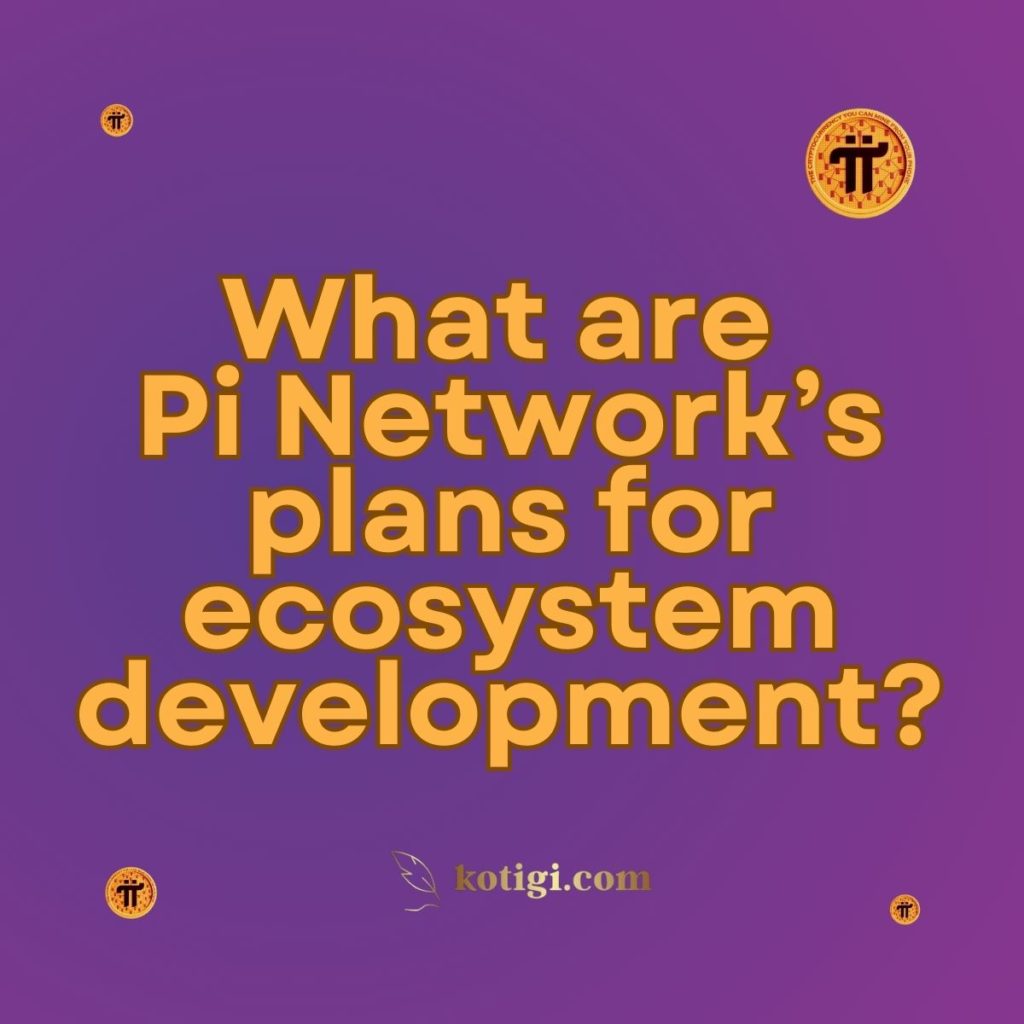
What are Pi Network’s plans for ecosystem development?
Pi Network is not just a cryptocurrency, but an entire ecosystem with a vision for decentralized finance (DeFi), dApps, and community-driven development. In this article, we explore Pi Network’s strategic plans for ecosystem development, including the integration of new technologies, expansion of the community, and the role of the Pi token in shaping the future of decentralized platforms.
Introduction
Pi Network, a unique cryptocurrency platform, is designed to enable users to mine cryptocurrency directly from their mobile devices. While its mining model is revolutionary in itself, the Pi Network is more than just a means for earning tokens—it is a comprehensive ecosystem that aims to empower developers, users, and businesses within a decentralized framework. Its vision extends to building decentralized applications (dApps), creating a fully functional economy, and enabling robust financial services through its native Pi token.
The network is currently in its development phase, with the launch of the Pi blockchain and the transition to its mainnet being key milestones. However, the broader ambition for Pi Network extends far beyond token distribution. This article will explore Pi Network’s strategic plans for ecosystem development, including its efforts to grow the Pi community, introduce decentralized financial services, encourage innovation, and establish a vibrant, scalable blockchain ecosystem.
1. Pi Network’s Vision for Ecosystem Development
1.1 A Decentralized, User-Centric Platform
Pi Network is focused on creating a decentralized ecosystem that places control back in the hands of users, developers, and businesses. At its core, the platform is designed to empower individuals by offering them access to a cryptocurrency system that is not controlled by any single entity. The aim is to decentralize financial and digital services while keeping the Pi Network community active and engaged.
- Decentralization: Pi Network’s structure is built to avoid the pitfalls of centralized control, giving every user a say in the development and governance of the ecosystem.
- Community Engagement: The platform prioritizes community involvement and allows its users, known as “Pioneers,” to participate in decision-making processes through community-driven governance models.
1.2 The Role of the Pi Token in Ecosystem Development
The Pi token will play an integral role in ecosystem growth. As the native currency, Pi will be used to facilitate transactions within the platform, pay for dApp services, and incentivize developers and users to engage with the network. Through staking, Pi holders will be able to earn rewards and participate in governance processes, which further strengthens the value proposition of holding Pi tokens.
- Utility in dApps: Pi tokens will power a range of decentralized applications within the ecosystem, enabling services like payments, data storage, and more.
- Staking and Governance: The ability to stake Pi tokens will encourage users to hold their tokens for longer periods, contributing to a stable token economy and further decentralization.
2. Pi Network’s Plans for Decentralized Applications (dApps)
2.1 Empowering Developers
A crucial part of Pi Network’s vision for ecosystem development is the creation of decentralized applications (dApps) that will run on the Pi blockchain. By providing developers with tools, resources, and an incentivized environment, Pi Network plans to become a hub for innovation, enabling the creation of new and disruptive technologies.
- Developer Incentives: Pi Network will offer rewards, grants, and technical support to developers creating dApps on its blockchain.
- Open Development Environment: Pi aims to maintain an open-source approach, ensuring that anyone in the Pi community can contribute to or build on the platform.
2.2 Types of dApps Expected
Pi Network envisions a variety of dApps that could be built within its ecosystem, addressing multiple sectors like finance, entertainment, and e-commerce. Some of the key types of dApps that could emerge include:
- DeFi Platforms: Decentralized financial services, including lending, borrowing, staking, and trading Pi tokens.
- Gaming and NFT Platforms: dApps that enable play-to-earn gaming models, as well as marketplaces for Non-Fungible Tokens (NFTs).
- Social Networks: Decentralized social media platforms where users have ownership and control over their data.
- E-Commerce: Peer-to-peer marketplaces that accept Pi tokens as payment for goods and services.
2.3 Pi Network’s dApp Ecosystem Goals
Pi Network’s goal is to develop an open and vibrant dApp ecosystem that is highly functional and capable of supporting millions of users. The network’s infrastructure is being designed to accommodate high transaction volumes and ensure seamless interaction with dApps.
3. Pi Network’s Integration with Decentralized Finance (DeFi)
3.1 Building DeFi Services on Pi Blockchain
Pi Network’s roadmap for DeFi integration is a key part of its broader vision for ecosystem development. Decentralized finance (DeFi) services have gained tremendous popularity over the past few years, enabling users to conduct financial activities without relying on traditional financial institutions.
Pi Network plans to launch DeFi services such as:
- Lending and Borrowing: A platform where Pi users can lend their tokens and borrow others’ tokens in a peer-to-peer manner, without the need for centralized banks.
- Staking Pools: Pi holders can stake their tokens to earn rewards, contributing to network security and governance.
- Yield Farming: Pi users can earn additional tokens by providing liquidity to decentralized exchanges or lending platforms.
3.2 Advantages of Pi’s DeFi Plans
By leveraging the liquidity from its 5 billion Pi tokens liquidity pool, Pi Network will offer users access to low-cost, high-yield financial services, without the barriers often imposed by traditional financial institutions.
- Accessibility: Pi’s DeFi services will make financial products accessible to users in regions where traditional banking systems are underdeveloped.
- Lower Transaction Costs: Users can benefit from lower fees compared to traditional financial systems, enhancing the platform’s appeal.
3.3 Encouraging Financial Inclusion
Pi Network’s DeFi services are also designed to promote financial inclusion. By enabling seamless transactions and decentralized lending platforms, Pi could offer financial services to the unbanked or underbanked populations, providing a powerful tool for economic empowerment.
4. Pi Network’s Approach to Community Building
4.1 Growing the Pi Pioneer Community
Pi Network is built on the principle of community-driven development. Its ability to grow and scale depends heavily on the active participation of its community, known as Pi Pioneers. Pi Network has implemented various strategies to foster growth, including referral programs, educational initiatives, and community engagement platforms.
- Referral Programs: Encouraging users to invite others to join Pi Network, thus expanding its user base.
- Educational Initiatives: Offering educational resources to help Pioneers understand the platform’s functionalities and the broader cryptocurrency landscape.
- Events and Contests: Hosting online and offline events to engage with users and keep the community active.
4.2 Role of Community in Governance
A key part of Pi Network’s decentralized approach is community governance. As Pi Network evolves, it plans to implement governance mechanisms that give its users a say in the platform’s development and policy decisions.
- Voting on Proposals: Pi Pioneers may be able to vote on important governance decisions, helping shape the future of the Pi ecosystem.
- Decentralized Leadership: Moving away from a single central entity to a more distributed leadership model, where key decisions are made by the community.
4.3 Building a Collaborative Environment
Pi Network encourages collaboration among its users and developers. It aims to create an environment where developers, users, and even businesses can collaborate seamlessly to build an ecosystem that benefits all parties.
5. Pi Network’s Plans for Token Utility and Adoption
5.1 Widespread Pi Token Usage
Pi Network’s vision includes creating real-world utility for the Pi token, ensuring that it becomes more than just a speculative asset. As the network develops, the Pi token will be used for:
- Payments for Goods and Services: Pi tokens will become a medium of exchange, allowing users to pay for goods and services both within the Pi ecosystem and in the wider world.
- Transaction Fees: Users can pay transaction fees with Pi tokens when interacting with dApps, ensuring Pi remains at the center of Pi’s decentralized economy.
5.2 Partnering with Businesses
To drive adoption, Pi Network plans to establish partnerships with businesses that will accept Pi tokens as payment. These partnerships will help introduce Pi to the broader public, creating real-world use cases for Pi tokens.
- E-Commerce Platforms: Pi could partner with online stores to allow Pi token payments, making the cryptocurrency more useful in everyday transactions.
- Physical Businesses: Encouraging businesses to accept Pi tokens as payment, fostering wider adoption and integration of Pi tokens in the real world.
6. Pi Network’s Technical Infrastructure
6.1 Transition to Mainnet
The transition to the mainnet is one of the most important steps in Pi Network’s plans for ecosystem development. The mainnet launch will enable Pi tokens to be fully decentralized, allowing for faster, more efficient transactions, and opening up the Pi blockchain to third-party developers.
- Mainnet Features: Enhanced security, faster transaction speeds, and the introduction of smart contract functionality will mark significant technical improvements for Pi.
- Interoperability with Other Blockchains: Pi Network also plans to explore partnerships with other blockchain networks to enhance interoperability and facilitate cross-chain transactions.
6.2 Scalability and Sustainability
Pi Network’s technical infrastructure is being developed to scale as the platform grows. Scalability is key to handling the increasing number of users, transactions, and dApps within the ecosystem.
- Layer 2 Solutions: Pi Network is considering the implementation of layer 2 solutions to increase scalability without sacrificing security.
- Sustainable Energy Usage: Pi Network will continue to focus on energy-efficient consensus mechanisms to ensure that its operations remain sustainable.
Conclusion
Pi Network’s plans for ecosystem development are both ambitious and exciting, with the goal of creating a decentralized, user-centric economy that empowers developers, users, and businesses alike. By fostering a thriving dApp ecosystem, enabling DeFi services, and encouraging widespread token adoption, Pi Network is positioning itself to be a key player in the future of blockchain technology. As it transitions to the mainnet and builds out its infrastructure, Pi Network’s vision for ecosystem development will undoubtedly continue to evolve, but its focus on decentralization, community-driven growth, and real-world utility will remain at its core.
List of Takeaways
- Pi Network aims to build a decentralized ecosystem where users, developers, and businesses can collaborate and contribute to the platform’s growth.
- The Pi token will be integral to the Pi ecosystem, powering decentralized applications (dApps) and enabling DeFi services.
- Decentralized Finance (DeFi) services, such as staking, lending, and yield farming, will play a pivotal role in Pi Network’s growth strategy.
- Community building is at the heart of Pi Network’s approach, with active participation from users encouraged through governance, referral programs, and educational resources.
- Pi Network plans to create real-world utility for its Pi token by partnering with businesses, enabling token payments, and driving adoption in both the digital and physical world.
- Interoperability and scalability are key considerations as Pi Network prepares for its transition to the mainnet, ensuring the platform can grow and meet the demands of its user base.
4o mini





